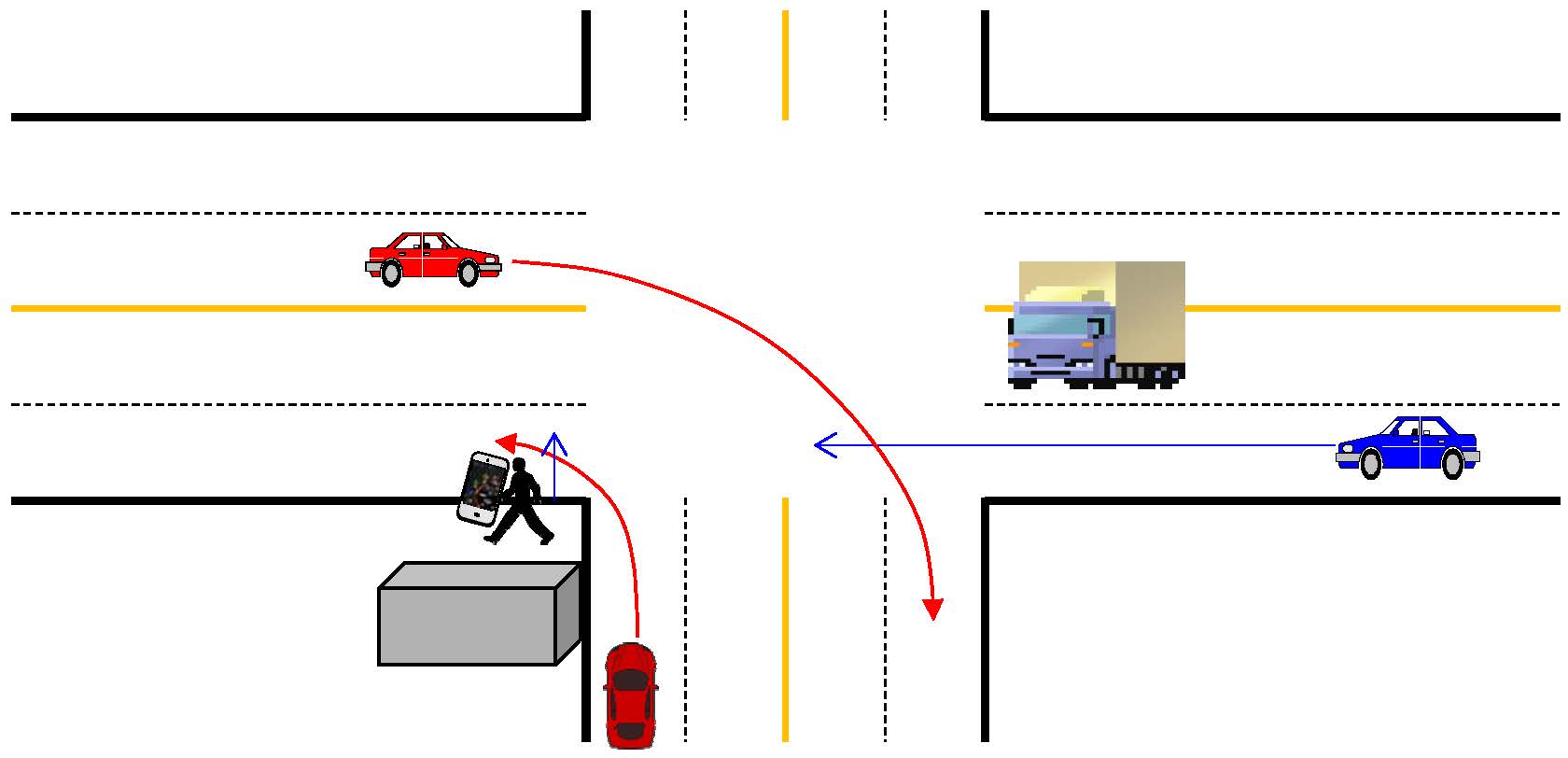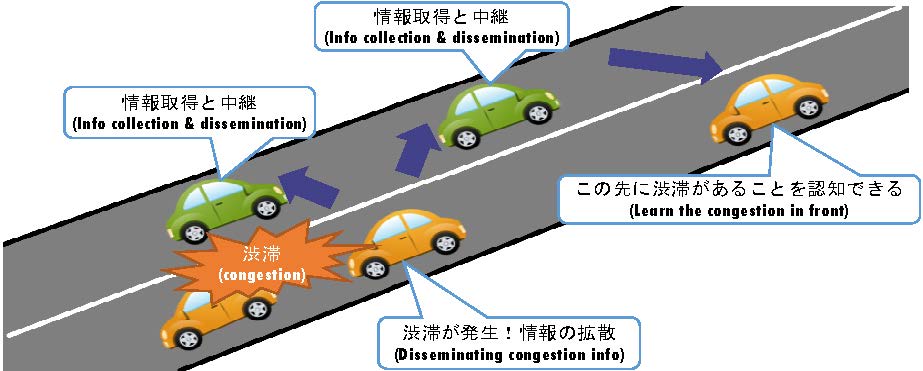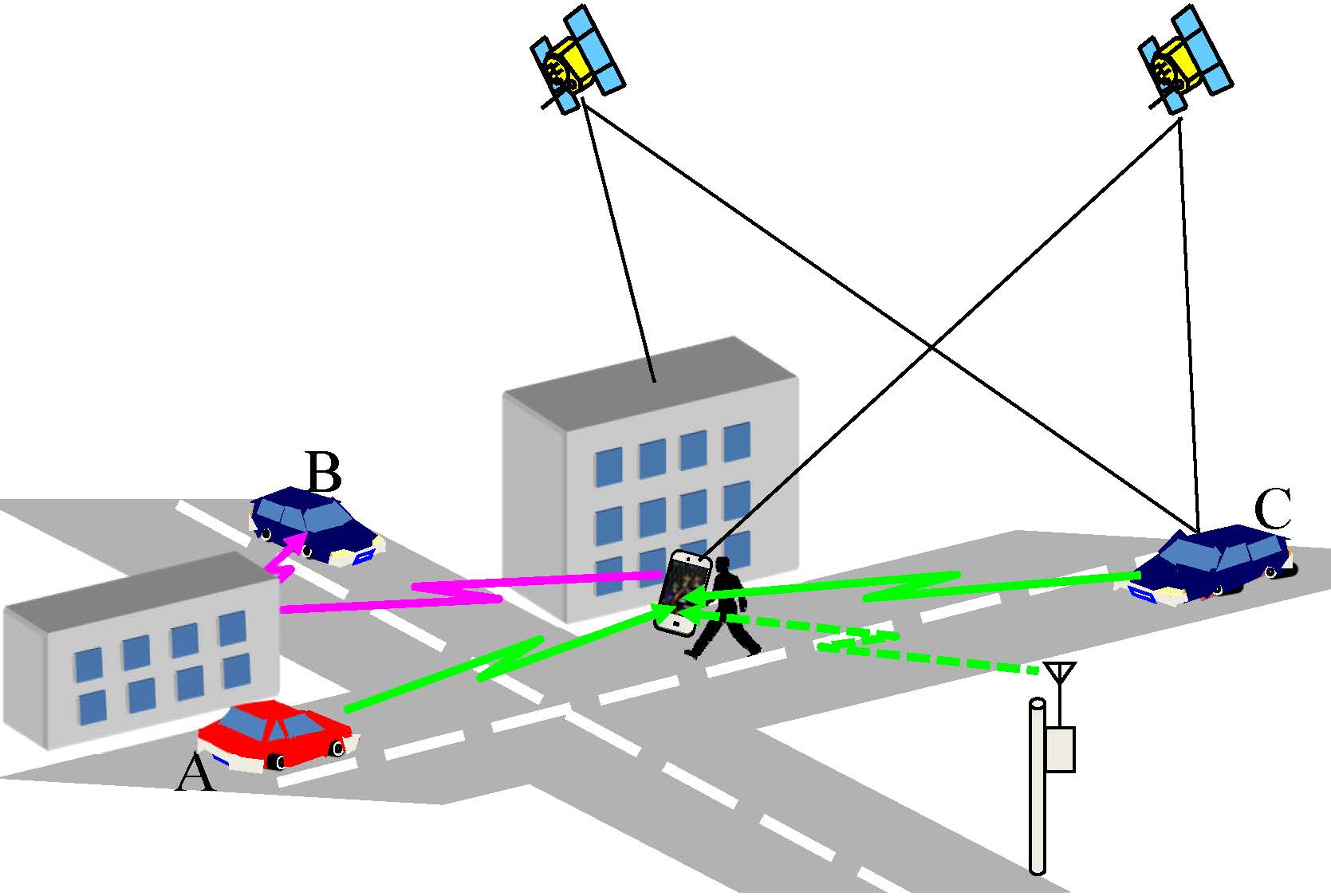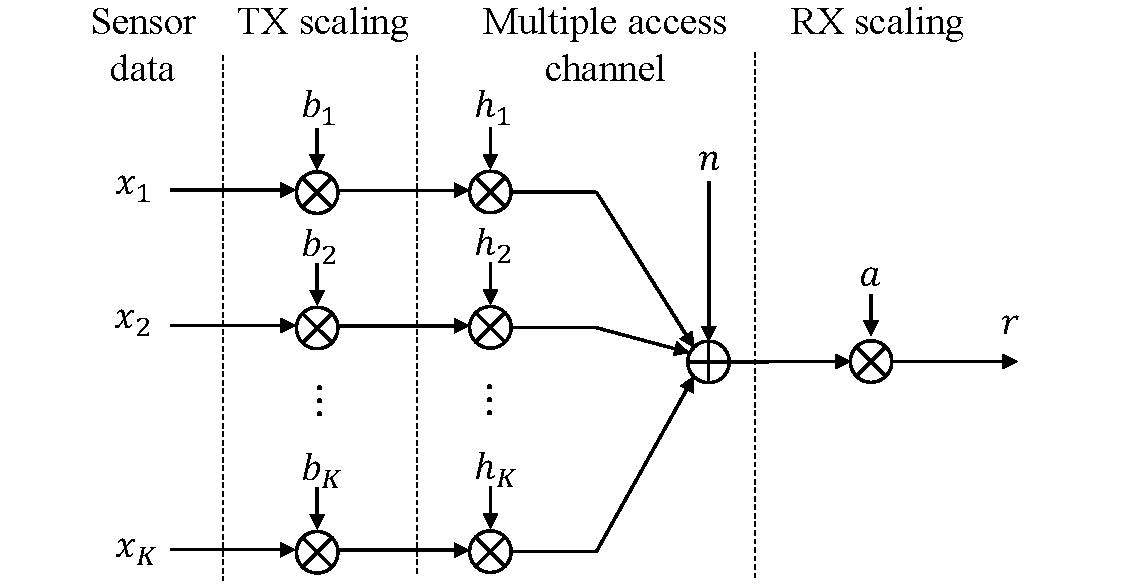RESEARCH
- Intelligent Transportation System (ITS)
- Energy efficient wireless communications, Sensor Networks, IoT
- Content centric network (CCN) and user centric network)
ITS (Intelligent Transportation System)
1.1 Inter-vehicle communications
Vehicles periodically exchange position information measured via GPS receivers, and learn the presence of their neighbors, especially when those vehicles are not directly visible due to the obstruction of other vehicles or roadside buildings. In this way, collision accidents between vehicles can be greatly reduced (Figure 1).

Figure 1 Avoiding collision accidents at intersections without line-of-sight by inter-vehicle communications and pedestrian-vehicle communications.
Vehicles sense traffic incidents (e.g., accidents, congestion, approaching of emergency vehicle) and exchange with neighbors, which helps to support smooth and comfortable driving (Figure 2).

Figure 2 Dissemination of traffic information by inter-vehicle communications.
In this work, we investigate how to improve the efficiency and reliability of inter-vehicle communications. Initial results were published in IPSJ Journal (2016 January) and ICICT 2018.
In order to improve efficiency of request/reply-based dissemination, we apply content-centric network techniques to inter-vehicle communication, and investigate the cache miss problem and how to adjust cache probability based on channel usage rate. Research results were published in APCC 2018 and MPDI Electronics (2020, pdf).
Until now, most efforts on inter-vehicle communication focus on DSRC (IEEE 802.11p). But DSRC is not put into practical use in other countries except Japan (in the 700MHz band). Therefore, 3GPP has started the standardization of Cellular-V2X (Vehicle-to-everything) in 5G. It consists of direct vehicle-to-vehicle communication (sidelink) and communication via base station, either of which requires resource allocation before actual transmission. Sidelink is suitable for the periodical message exchange between adjacent vehicles, and its resource allocation can be done either via a base station in a centralized way or by vehicles themselves in a distributed way. In order to realize highly reliable communication on sidelink, a new resource allocation method, which considers the usage status of each resource block and the different transmission intervals of vehicles, was proposed and evaluated, and the research results were published in VNC 2020, IPSJ Journal (April 2022 issue), IEEE Access (2022, pdf).
In order to achieve both low-latency and high reliability of inter-vehicle communication, we try to combine DSRC with Cellular-V2X, and the initial results were published in Globecom 2019 V2X Workshop.
Matlab code for V2X sidelink simulation can be downloaded from here (V2X-SPS code).
1.2 Pedestrian-to-vehicle communications
In order to protect pedestrians from traffic accidents at intersections without line-of-sight, it is necessary to deliver pedestrian position information to vehicles in real time (Figure 1).
In this work, we investigate the efficiency of pedestrian-to-vehicle communication, and power saving of pedestrian-held mobile devices. Initial result was published in IEEE ICVES 2015 and IEEE VTC2021-Spring.
1.3 Pedestrian positioning
Position of pedestrian can be measured by GPS receiver embedded in mobile devices. In urban area, however, due to obstruction/reflection of GPS signals by roadside buildings, position precision is greatly degraded, or even outage occurs when no enough satellites are available.
Due to the obstruction/reflection of roadside building, the measured distance between a receiver and a satellite has a multipath error. We investigate the spatial and temporal correlation in multipath error and on this basis build a model to reduce multipath error at a pedestrian receiver. Initial results were published in IEEE ICVES 2018.
In order to solve the outage problem where the number of satellites is insufficient for positioning, in this work, we try to treat vehicles and road-side units with high precision positions as pseudo-satellites and use wireless signals from these devices to improve the precision of pedestrian positions. (Figure 3)
Research results were reported in ITS World Congress 2016, and published in IPSJ Journal (2018), IET Intelligent Transportation Systems (2018, pdf), and IPSJ Journal (2019).
We further investigate how to use the angle between a pedestrian and vehicles. It is difficult to equip a pedestrian device with many antennas due to the size limit. Therefore, we investigate the phase variation at a pedestrian device when a vehicle moves while transmitting a signal, estimate the pedestrian-vehicle angle with a single antenna, and apply it to pedestrian positioning. Initial results were published in IEEE ICVES 2019 and MDPI Sensors (2020, pdf).
Considering the potential equipment of multiple antennas at a mobile device, we propose a new method to estimate angle of arrival (AoA) precisely by jointly using spatial change of CSI at multiple antennas and temporal change of CSI per antenna (caused by pedestrian/vehicle movement), and on this basis improve pedestrian positioning precision. Specifically, a two-dimensional antenna array is constructed from CSI acquired from multiple antennas/timings, and the MUSIC method with spatial smoothing is applied to estimate AoA. The performance relies more on temporal CSI when the number of antennas is small and depends more on spatial CSI as the number of antennas increases. The research results were published in IEEE Access (2021, pdf).
In order to achieve high accuracy pedestrian position, we have investigated a new method for estimating distance difference between a pedestrian and two anchors, using phase information that is more resistant to noise, compared with RSSI that depends on radio wave attenuation characteristics. By the double phase difference, error factors such as OFDM modulation data and carrier frequency variations can be mitigated, and inter-symbol interference can be avoided by adjusting the sampling time. Furthermore, it is confirmed that multipath waves can be suppressed by using multiple frequencies at the same time, and the result in the multipath-rich environment is promising. The initial results were published in IEEE VTC2022-Fall, IEEE VTC2022-Fall and IEEE Access (2023, pdf).

Figure 3 High precision pedestrian positioning by treating vehicles and road-site units as anchors (pseudo-satellites).
1.4 Indoor positioning
We also investigate how to use BLE (Bluetooth low energy) in multiple wearable devices to improve the precision of indoor positioning.
1.5 Location-based system
Triggered by the receiving of inver-vehicle communication messages exchanged between vehicles, mobile device of a pedestrian estimates the context of the pedestrian and his degree of risk, based on which, prioritized transmission control for pedestrian-to-vehicle communication can be realized. Accident rate of pedestrians depends on venues they are in. In other words, venue information of pedestrian is an important factor in determining the degree of risk of pedestrians. Here, each venue is represented by a polygon, and each pedestrian is represented by a point. On a digital map, the matching between points and polygons indicate which venue a pedestrian is currently in. We investigated how to improve the efficiency of this matching, and the research result was published in ACM Transactions on Spatial Algorithms and Systems (2015, pdf).
Energy efficient wireless communications, Sensor Networks, IoT
2.1 Wake-up receivers
In order to be ready to receive any incoming packets instantly, RF circuits of mobile devices are kept in monitoring the channel, which consumes much power. If a mobile device is put into sleep in its idle state, and activated when new traffic is generated, its power consumption can be greatly reduced. A lower power wake-up receiver is necessary in order to remotely activate a device on-demand (Figure 4).

Figure 4 Power save by sleep/wake-up control of mobile devices.
In this work, we investigate how to design low-power wake-up receiver.
We designed a low-power wake-up receiver, which works in the 2.4GHz ISM band, shares the antenna with co-located wireless LAN module, and detects wake-up signal by envelope detection instead of coherent detection. To realize reliable delivery of wake-up messages in the congested 2.4GHz ISM band, we investigated the coexistence of wake-up signals and wireless LAN signals (MAC protocol) and how to distinguish wake-up signals from wireless LAN signals (PHY protocol). Research results were published in IEEE GLOBECOM 2011 and EURASIP Journal on Wireless Communications and Networking (2012, pdf), respectively.
In order to facilitate the widespread of radio-on-demand wireless LAN, we also studied how to exploit wireless LAN modules to deliver wake-up signals to activate receivers. The research results, which adjust frame length (physical transmission time) of wireless LAN signals to deliver wake-up signals, were published in IEEE PIMRC 2011 and Elsevier Computer Communications (2012). In order to improve the reliability, burst transmission of wireless LAN frames and its extension were published in IEEE ICC 2012 and IEEE Transactions on Vehicular Communications (2015, pdf), respectively. In addition, we also investigated how to optimize the parameters in envelope detection, and this result was published in IEEE Wireless Communications Letter (2015, pdf).
2.2 Wake-up protocols
When multiple nodes share the same channel, and have to wait for the channel to become idle to send their packets, much power is wasted in the idle listening. To solve this problem, a low power wake-up radio is used to monitor the channel instead of the power-hungry data transceiver. Then, fine-grained, micro sleep/wake-up control, e.g., using wake-up radio for carrier sense and activating a wireless LAN module in the packet level, can be achieved by tightly integrating a wake-up radio and a data transceiver. Initial results were published in IEEE PIMRC 2016 and IEEE Globecom 2016, respectively.
When a data transceiver receives a wake-up signal, it has to transit from sleep to the active state, and cannot start the transmission before preparing its clock etc. The delay between the wake-up instruction and the time a data transceiver starts the transmission is called wake-up latency. Multiple nodes may falsely be activated due to the wake-up latency. To solve this problem, we investigated how to reduce the false wake-up probability, and reduce the false wake-up time. Research result was published in Springer Wireless Networks (2018, pdf).
In the downlink, when several nodes in the power save mode are associated with the same access point, they need to periodically wake up to receive beacons in order to get the traffic indication map. Once the downlink traffic is detected, a node will remain in the active state until its packets are received. Here, periodical wake-up and the idle listening until the end of packet receiving lead to energy waste. To solve this problem, the traffic indication map is sent to each node by wake-up signal. The wake-up radio of each node keeps monitoring the link quality and channel usage, and tries to activates its own data transceiver when the link quality is high, which both reduces power consumption and improves channel efficiency. Research result was published in Wireless Communications and Mobile Computing (2017, pdf).
2.3 Sensor network
In large-scale wireless sensor networks (WSNs) for wild environments, nodes once deployed run only on battery. Moreover, nodes close to a sink consume energy more quickly than other nodes due to packet forwarding. Mobile sink is a good solution to this issue, although it causes two new problems to nodes: (i) overhead of updating routing information and (ii) increased operating time due to aperiodic query.
In this work, we solve these problems by proposing a sink-based centralized transmission scheduling method, which uses asymmetric communication and wake-up radio. Specifically, nodes do not update route information. Instead, the sink determines the transmission order. In addition, each node is equipped with a wake-up radio. At the time that a packet transmission between two nodes is scheduled, the sink transmits a wake-up message using a large transmission power, directly activating both nodes simultaneously to communicate. The initial result was published in IEEE WCNC 2017, and the latest result was published in MDPI Sensors (2018, pdf).
2.4 IoT
In the IoT era, IoT devices are deployed densely, up to 1 million nodes in 1 square kilometer. How to make these IoT devices efficiently communicate with a sink node is a big challenge.
In IoT sensor networks, data collection and processing usually are separated, both in the digital domain. The former involves the one-by-one data transmission, which will take much time when there are many nodes in a cell. This is a challenging problem, because of limited spectrum bandwidth, real-time requirement, and the transmission collisions in the multiple access channel.
For some tasks, the sensing process actually does not require the individual value from each sensor, if only their fusion, e.g., sum, average, max, etc., is computed correctly. This can be achieved by a new policy called over-the-air computation (AirComp, Figure 5), which integrates the data collection and fusion in the analog domain using uncoded transmissions. AirComp only takes one slot for data collection, which is very efficient. Although AirComp generally only supports the sum fusion, by proper pre-processing and post-processing operations, it can be extended to support any kind of nomographic functions.

Figure 5 Over-the-air computation
We investigate how to use relay, more specifically, AF(Amplify-and-Forward)-based relay, to improve the performance of AirComp. AF is considered because signals in AirComp are transmitted in the analog wave. In the communication, the relay node will amplify signals from many nodes and forward them to the sink, and the whole process should try to ensure the alignment of signal magnitudes at the sink so as to reduce the computation error. This leads to large relay transmission power. To solve this problem, we first divide nodes into groups, and further propose a coherent relay (CohRelay) policy, in which a node can divide its power to transmit its signal to both the relay and the sink, and the replicas of its signal are coherently combined together at the sink. We also discuss the tradeoff between computation error and transmission power. The initial result was published in IEEE Access (2021, pdf). Considering the constraint of relay transmission power, we further study how to schedule nodes to use the relay so as to both reduce the computation error and suppress the power consumption. The result was published in IEEE Wireless Communications Letters (2022, pdf).
In over-the-air computation, the optimum parameters are computed at the sink, based on the channel gain of each node. Most studies assume that the sink knows the latest channel gains of all nodes. However, channel gain can dynamically change, and collecting channel gains of all nodes every time a computation is performed would take a lot of time, which greatly degrades the efficiency. In order to alleviate this problem, we investigated a new method, which relies on the statistical values of channel gains rather than the instantaneous ones. Specifically, the sink sets a threshold based on channel gain statistics. Each node compares its own channel gain with the threshold. It transmits its signal immediately if its channel gain is above the threshold, and waits otherwise. This can significantly reduce computation errors. Parameter optimization, theoretical analysis, and simulation evaluation results were published in IEEE Transactions on Wireless Communications (2023, pdf).
In the multi-antenna case, usually the zero-forcing policy is used to enforce signal magnitude alignment (no distortion), which, however, increases noise and affects the overall computation error. To better exploit multiple antennas at the sink, we proposed a misalignment allowed optimization (Miso) method for AirComp. Specifically, a group of nodes whose signals may be misaligned are dynamically selected, and other signals are aligned to a higher level with higher quality. On this basis, the optimization of multi-antenna AirComp is converted to a difference of convex problem and is solved iteratively. Simulations confirm that the proposed method greatly reduces computation error and scales better with the number of nodes, compared with previous methods. Theoretical analysis and simulation evaluation results were published in IEEE Internet of Things Journal (2023, pdf).
Content centric network and user centric network
In content-centric network, a user requests a content chunk (e.g., a video slice) by using a unique content name (not need to know where the content is) instead of the conventional IP address. Because a popular content usually is repeatedly accessed by different users, end-to-end delivery of content for each user is not efficient. Therefore, in-network caching is usually adopted. But a problem is that popular contents are cached multiple times, duplicate in local networks, while there is no enough cache space for non-popular contents, whose access still require end-to-end delivery.
In this work, we investigate cooperative caching between CCN nodes so as to cache more contents with limited buffer space.
Popularity of content depends on topics and user preference. In addition, popularity of content changes with places. We will investigate how to predict content topics and user preference, and on this basis realize efficient caching.
Past research: Ad hoc networks
Routing protocol
In mobile ad hoc network, link quality (e.g., transmission rate) is not considered in route discovery in on-demand routing protocols. When a link breaks due to node mobility, the route is reconstructed, but this causes packet loss and delay, besides routing overhead.
To solve this problem, we designed a protocol, taking into account in routing metric design received signal strength (RSSI) which reflects link quality and node mobility. Link cost is computed in such a way that strong RSSI leads to small cost, and a route with a small cost is used as the initial path. As link quality gradually degrades due to node mobility, an alternative path, which is around the current active path but with smaller cost, is activated as the new route. This method was extensively evaluated by both simulation and testbed experiments. The reseach results were published in APCC 2004 and IEICE Transactions on Communications (2005, pdf), respectively.
Past research: Network coding
It is known that relay (e.g., decode-and-forward) can help to improve the reliability of wireless communication. The efficiency of relay can be improved by network coding. We investigated two kinds of relay scenarios.
Multiple access uplink. When two nodes near the cell edge try to send packets to the same access point (AP), a typical relay method is to let the relay node separately forward the packets. Alternatively, combining the two packets as a network coded packet can improve the relay efficiency. With the network coded packet received from the relay node, and original packets directly received from two nodes, AP can perform joint network and channel decoding to recover the original packets. The research results were published in IEEE ICCS 2008 and IEICE Transactions on Communications (2009, pdf), respectively.
Broadcast channel. When two nodes exchange packets via a relay node, the relay node broadcasts a network coded packet to the two nodes. When two links support different rates, the network coded packet is transmitted at the lower rate, in order to make sure that the network coded packet correctly arrives both nodes. This rate mismatch problem greatly degrades the performance of network coding. To solve this problem, we re-interpret network coding by constellation mapping, and on this basis, propose a cross-layer design, which embeds low-rate constellation into high-rate constellation. In this way, when the network coded packet is transmitted, it can reach the highest rate on each link, which approaches the Shannon capacity of broadcast channel. The research results were published in IEEE GLOBECOM 2010 (ppt) and EURASIP Journal on Wireless Communications and Networking (2011, pdf), respectively.